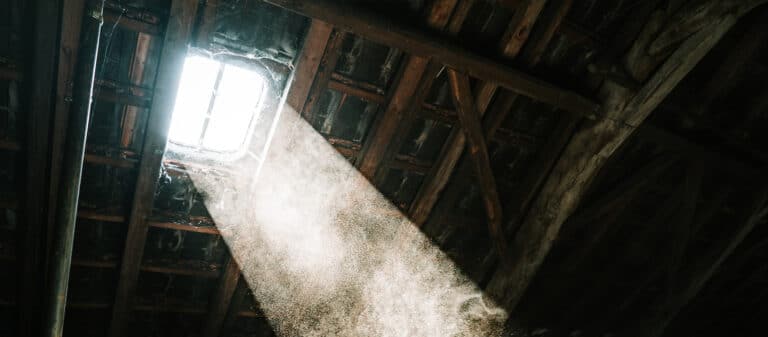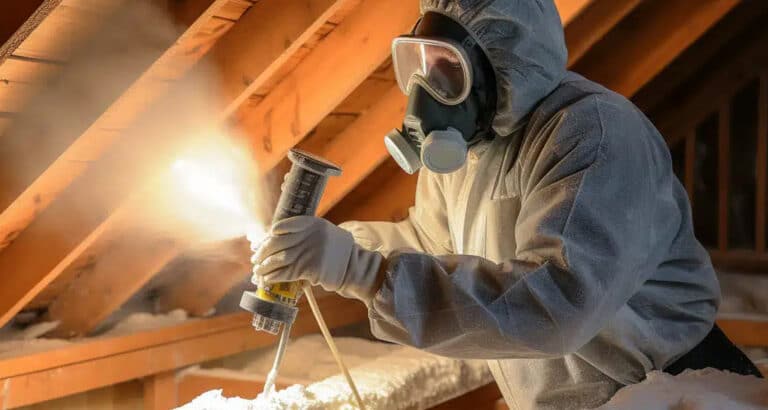Fiberglass batt insulation is one of the most widely available and beginner-friendly insulation materials on the market.
Offering high thermal resistance, non-combustible materials, and simple application, fiberglass batts are a versatile insulation option for nearly any project in Northeast Pennsylvania.
While easy to install, fiberglass batts perform best when installed by a professional who can consider various factors, such as the proper R-value, adequate ventilation, and potential fire hazards.
We strongly recommend professional installation if you live in an older home in Northeast Pennsylvania or have existing insulation that needs to be removed or added to.
There are also several other insulation materials available, including spray foam and blown-in insulation, which may be better suited for enclosed wall cavities or newer homes.
This guide will discuss the benefits of batt insulation and compare it to other insulation materials, allowing you to determine if batt insulation is the right choice for your next project.
What Is Batt Insulation?
Batt insulation, commonly referred to as fiberglass batts, are pre-cut sections of insulation designed to fit snugly between the studs, joists, and rafters in your home’s walls, floors, and ceilings. While fiberglass is the most common material, some batts may consist of cotton, mineral wool, or other recycled materials.
Batt insulation can be found in most big-box home improvement stores in pre-cut sections designed to fit common stud spacings, such as 16” or 24” on center. Each batt will have a standard R-value (thermal resistance value) based on its thickness and the effectiveness of the insulation material in preventing thermal transfer.
How Does Batt Insulation Work?
Batt insulation works by trapping tiny pockets of air within breathable fibers to create a thermal barrier and slow the transfer of heat. This makes fiberglass batts versatile for both cold and warm seasons in the northeast.
- In the winter, fiberglass batts keep warm air inside and prevent cold air from creeping through walls or ceilings.
- In the summer, fiberglass batts block hot outdoor air from entering and reduce the strain on your cooling system.
The result of this thermal barrier is less strain on your HVAC system, better temperature regulation, and lower energy bills.
The Role of R-Value in Batt Insulation
As previously mentioned, R-value is a measure of the batt’s thermal resistance or how well it can trap or block out heat.
When shopping for fiberglass batts, you’ll typically find the following R-value ranges, designed to meet the recommended R-values for your area, which can be found here.
Thickness | R-Value Range |
3.5 inches (typically for 2×4 walls) | R-11 to R-15 |
6 to 6.25 inches (typically for 2×6 walls) | R-19 to R-21 |
9.5 inches (attic floors) | R-30 |
12 inches (attic floors) | R-38 |
16 inches (attic floors) | R-49 |
For homeowners in Northeast Pennsylvania, these R-Values should align with recommendations for Climate Zone 5. For example, attics should ideally be insulated to an R-value of 49 or higher, while exterior walls often require an R-value of 13 to 21.
Benefits of Batt Insulation
Fiberglass batt insulation is a versatile and ubiquitous material that can add improved energy efficiency and value to any home. Here are some benefits of upgrading to batt insulation.
1. Improved Energy Efficiency
When installed properly, batt insulation can reduce the amount of energy your home uses to maintain comfortable temperatures. This means your heating and cooling systems don’t have to work as hard, especially during Northeast PA’s harsh winters. Batt insulation can also improve temperature regulation, eliminating cold spots and drafts.
2. Lower Energy Bills
Batt insulation provides high thermal resistance, preventing cold air from entering your home. In turn, you can expect lower energy bills and an eventual return on your investment.
3. Moisture Resistance
One benefit of batt insulation over other types of insulation is its moisture resistance. Since fiberglass batts are breathable and the material is non-viable for food, there is little risk of mold buildup or moisture damaging your insulation material.
However, we still recommend installing vapor barriers over the face of the batts to prevent moisture buildup in wall cavities.
4. Noise Reduction
Since batt insulation is typically a thicker material, it tends to offer more of a sound barrier over blown-in insulation. This can create more privacy between rooms and improve the overall comfort of your home.
5. Environmentally Friendly Options
Many batt insulation products are now made with recycled materials and are manufactured in a way that minimizes environmental impact. If going green is a big priority for your home, then recycled fiberglass batts or blown-in cellulose offer two excellent options.
Batt Insulation vs. Other Insulation Types
Batt insulation is one of the most popular types of insulation on the market, but it’s not necessarily the most efficient. Here’s how it stacks up against other types:
Insulation Type | Strengths | Weaknesses |
Batt Insulation | Cost-effective, easy to install, readily available | Must be properly cut and fitted to avoid gaps |
Blown-In Insulation (Fiberglass and Cellulose) | Great for filling irregular spaces and attics | Can settle over time if not properly installed |
Spray Foam Insulation | High R-Value, air seals as it insulates | Higher upfront cost, professional installation needed |
Rigid Foam Board | High R-Value per inch, moisture-resistant | Typically used in specific applications rather than whole walls |
Batt insulation is particularly advantageous for wall cavities, attics, and floors. When installed correctly, it strikes the optimal balance between performance and affordability.
Is Batt Insulation DIY Friendly?
While batt insulation is the most DIY-friendly of those available, professional installation is still recommended.
For one, crushing or compressing the insulation while installing it can greatly impact its performance. Vapor barriers must also be installed on the face to prevent moisture buildup that can rot out your walls or ceilings.
Finally, any gaps or cracks could compromise your investment, leading to air leaks and cold drafts that make your home uncomfortable.
Overall, batt insulation is a great source of heat resistance that can help lower bills and improve overall home comfort. If you’re looking for professional assistance to install your batt insulation in Northeast Pennsylvania, contact the experts at EnergySmart for a free quote.
FAQs: Batt Insulation
What is batt insulation made of?
Batt insulation is commonly made from fiberglass, mineral wool, or recycled cotton fibers. Fiberglass is the most widely used because it offers good thermal resistance at an affordable price.
Does batt insulation help lower energy bills?
Yes! Properly installed batt insulation reduces the amount of energy needed to heat or cool your home, which lowers monthly utility costs.
How long does batt insulation last?
Batt insulation can last for decades if kept dry and undisturbed. However, it can lose effectiveness if compressed, damaged, or exposed to moisture.
Can I install batt insulation myself?
While batt insulation is DIY-friendly for simple projects, professional installation ensures maximum energy efficiency and prevents common mistakes like gaps, compression, or misalignment.











